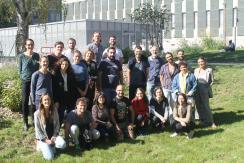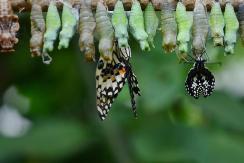COEVOL Multi-Scale Coevolution
Living systems are highly integrated, with a multitude of levels of organization, from molecular and intra-cellular scales to ecosystems. Complex organisms are themselves consortia of macro- and micro-organisms, which work together with their host to build the individual. Yet, each of these organisms can function and evolve in the short term according to its own logic, possibly in conflict with other higher or lower levels, or with other time scales. The once common idea among evolutionists that natural selection results in organisms perfectly adapted to their environment is now severely undermined. Not only because, as the Red Queen explains to Alice, one has to run relentlessly to keep its place in a changing environment, or because past evolutionary history and chance constrain the possibilities of present adaptation, but also because different levels of selection have interests that are generally difficult to reconcile.
Multi-scale coevolution resets classical questions in evolutionary biology
One example, of particular interest is the question of the source of heritable variations. The phenotype of organisms in a population is influenced not only by variations in their nuclear and mitochondrial genomes, the dynamics of which is the object of population genetics, but also more and more patently by the consortium of microbes and genetic elements that constitute its microbiome and virome. The hologenome designates this complex assembly of genetic materials, which obey different rules of transmission and different evolutionary strategies. The ability of symbionts to manipulate host phenotypes or to interfere with each other influences the evolutionary dynamics of all players in ways that are yet poorly understood. In addition, new questions arise, such as the importance of co-adaptation in these systems and their consequences in maintaining cohesive biological systems.
- Symbiosis: a response to and a source of divergent selection
Using a variety of approaches combining experimental evolution, genomic, functional, phenotypic and behavioral data, we aim to test whether symbiosis facilitates diversification and to characterize the underlying microevolutionary processes.
- Ecological networks of horizontal gene transfer
We develop original methods to detect gene transfer and we investigate the factors that influence the routes of gene transfers among microbes but also among insects.
- The interplay between symbiosis, infection and immunity and its evolutionary consequences
We try to understand the intimate interaction of hosts with pathogens, symbionts and transposable elements and how it affects the extended phenotype of the host.
- Transgenerational inheritance and environment changes
We try to decipher the molecular mechanisms that underlie rapid adaptation to environment and to test for transgenerational inheritance of fitness traits.
- Intragenomic conflicts and demography
We are developing models to test whether changes in the demography of the host affect the dynamics of transposable elements.
- The determinism of phenotypic convergence
We study the genomic basis of convergent phenotypic evolution in particular in the case of animals and plants adaptation to increasing temperature and decreasing water.
- Reconciling the tree of life
We develop phylogenetic methods for “reconciling” gene/species or host/symbiont histories and use these methods to explore the bulk of extinct or undescribed species and the history of association of symbiotic microbes with their hosts.
Integrating methods
The methods we use to tackle the questions raised by multi-scale co-evolution extend from theory, modelling and simulation to big data analysis, lab (notably on insects), and to a lesser extent, field activities.
Implication of research, responsibility of researchers and citizen sciences
From our research (some of which have immediate consequences in health, agriculture and ecology) and our concerns about the responsibility of scientists in society, we are committed to promote an “implicative” research. The implicative position means that we try to work on the link between science and society, not only through a one-way communication, applying or explaining our science, but also favoring early discussions on research projects, that may influence our research directions.
Publications
Display of 541 to 570 publications on 709 in total
The fate of the duplicated androgen receptor in fishes: a late neofunctionalization event ?
BMC Evolutionary Biology . 8:336 : 1-19
Journal article
see the publicationGenetic and Immunological Comparison of the Cladoceran Parasite Pasteuria ramosa with the Nematode Parasite Pasteuria penetrans
Applied and Environmental Microbiology . 74 : 259-264
Journal article
see the publicationVariable-Number-of-Tandem-Repeats Analysis of Genetic Diversity in Pasteuria ramosa
Current Microbiology . 56 : 447-452
Journal article
see the publicationHigh Genetic Differentiation between the M and S Molecular Forms of Anopheles gambiae in Africa
PLoS ONE . 3 : 1-7
Journal article
see the publicationExploring the Solution Space of Sorting by Reversals, with Experiments and an Application to Evolution
IEEE/ACM Transactions on Computational Biology and Bioinformatics . 5 ( 3 ) : 348-356
DOI: 10.1109/TCBB.2008.16
Journal article
see the publicationPrecise detection of rearrangement breakpoints in mammalian chromosomes
: 26
Report
see the publicationPrédiction de synténies dans le génome ancestral des amniotes
Journées Ouvertes de Biologie, Informatique et Mathématiques, JOBIM 2008 . : 141-148
Conference paper
see the publicationPerfect DCJ rearrangement
RECOMB-CG: Comparative Genomics . LNCS ( 5267 ) : 158-169
Conference paper
see the publicationAdvances on Stochastic Local Search Algorithms for the Genomic Median Problem
International Conference on Metaheuristics and Nature Inspired Computing (META) . 4872 : 266-276
Conference paper
see the publicationMultichromosomal Genome Median and Halving Problems
International Workshop on Algorithms in Bioinformatics (WABI) . 5251 : 1-13
Conference paper
see the publicationA Methodological Framework for the Reconstruction of Contiguous Regions of Ancestral Genomes and Its Application to Mammalian Genomes
PLoS Computational Biology . 4 : 391-410
Journal article
see the publicationSorting Signed Permutations by Reversal (Reversal Sequence) 2004; Tannier Sagot
incollection . -- : 860-863
Journal article
see the publicationThe heterochromatic copies of the LTR retrotransposons as a record of the genomic events that have shaped the Drosophila melanogaster genome
Gene . 411 : 87-93
Journal article
see the publicationLosing helena: The extinction of a drosophila line-like element
BMC Genomics . 9 : 1-11
Journal article
see the publicationEtude des patrons d`évolution asymétrique dans les séquences d`ADN
incollection . -- : 476-482
Journal article
see the publicationIn response to comment on ‘A congruence index for testing topological similarity between trees’
Bioinformatics . 25 ( 1 ) : 150--151
Journal article
see the publicationIntense transpositional activity of insertion sequences in an ancient obligate endosymbiont
Molecular Biology and Evolution . 25 ( 9 ) : 1889-1896
Journal article
see the publicationIs symbiosis evolution influenced by the pleiotropic role of programmed cell death in immunity an development ?
Insect Symbiosis . 3 : 57-76
Book chapter
see the publicationMesophilic crenarchaeota: proposal for a third archaeal phylum, the Thaumarchaeota.
Nature Reviews Microbiology . 6 ( 3 ) : 245-252
DOI: 10.1038/nrmicro1852
Journal article
see the publicationAccounting for horizontal gene transfers explains conflicting hypotheses regarding the position of aquificales in the phylogeny of Bacteria
BMC Evolutionary Biology . 8 : 272-272
Journal article
see the publicationNon-homogeneous models of sequence evolution in the Bio++ suite of libraries and programs
BMC Evolutionary Biology . 8:255 : 31-42
Journal article
see the publicationPhylogenetic Characterization and Prevalence of “Spirobacillus cienkowskii ” a Red-Pigmented Spiral-Shaped Bacterial Pathogen of Freshwater Daphnia Species
Applied and Environmental Microbiology . 74 : 1575-1582
Journal article
see the publicationThe effects of multiple infections on the expression and evolution of virulence in a daphnia-endoparasite system
Evolution - International Journal of Organic Evolution . 62-7 : 1700-1711
Journal article
see the publicationSpeciation in fungi
Fungal Genetics and Biology . 45 ( 6 ) : 791--802
Journal article
see the publicationDémasquage des gènes spécifiques d'une espèce génomique du complexeAgrobacterium tumefaciens par AFLP et multicapteur à ADN
7. Colloque national du Bureau des Ressources Génétiques . 7
Conference paper
see the publicationDealing with incongruence in phylogenomic analyses
Philosophical Transactions of the Royal Society B: Biological Sciences . -- : 1233-1241
Journal article
see the publicationPrecise detection of rearrangement breakpoints in mammalian chromosomes
BMC Bioinformatics . 9 ( 1 ) : 286
Journal article
see the publicationReactive Stochastic Local Search Algorithms for the Genomic Median Problem
European Conference on Evolutionary Computation in Combinatorial Optimization (EvoCOP) . 4972 : 266-276
Conference paper
see the publicationA Methodological Framework for the Reconstruction of Contiguous Regions of Ancestral Genomes and its Application to Mammalian Genomes
: 26
Report
see the publication

